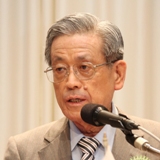Lesson We Learn from Environmental Preservation of Edo Period
May 19, 2010
Mr. Makoto Takeuchi
Director General, Edo-Tokyo Museum
 ��Recently, I had a chance to go up as high as 150m on the much talked-about Tokyo Sky Tree, which will become the tallest structure in Japan reaching a height of 632 meters. With the first observatory on 350-meter-level and the second one on 450-meter-level, it will surely give you a splendid view over the new Tokyo.
��Recently, I had a chance to go up as high as 150m on the much talked-about Tokyo Sky Tree, which will become the tallest structure in Japan reaching a height of 632 meters. With the first observatory on 350-meter-level and the second one on 450-meter-level, it will surely give you a splendid view over the new Tokyo.
��Mr. Totsune, a young designer, undertakes the lighting design of this tower. He told me during our interview that he intended to use LED (light-emitting diode) lights to save energy and protect the environment. He also plans to switch the light-up colors daily, from purple representing ��stylishness�� to pale yellow representing ��elegance��, making effective use of the contrast of light and shade.
��I admire his choice of colors which represent the old Japanese cultures of both stylish Edo and elegant Kyoto. The location of this tower is Oshiage of Sumida ward, where the long traditions from the Edo period still exist today. I am sure Mr. Totsune intended this tower to represent Japan as a whole, by combining the elements of 2 major cultures of Edo and Kyoto.
��Keisai Kuwagata, an artist of Edo period, painted the aerial view from Mukoujima (Sumida ward) over the Edo metropolis in his screen work, ��Glimpse of Edo,�� currently possessed by the Local History Museum of Tsuyama.
��Mukoujima is the very spot where the Tokyo Sky Tree is now being constructed. This painting shows how beautiful Edo was, with abundant greenery and water. Sumida River runs below, with Edo castle in the background and Mt. Fuji far beyond. I suggested to the president of Sky Tree to display the replica of this screen work on the observatory to make comparison between what Tokyo looked like during the Edo period and how much it has developed today.
��Now, how did foreigners observe Edo? They always made comparisons between Japan and their native countries or other countries they had visited. These comparisons teach us many things.
��A British botanist Robert Fortune visited Japan towards the end of the Tokugawa shogunate and wrote, ��Edo is an amazing place with special features that constantly attracts foreigners. Edo is a metropolis in the East, where the castle is surrounded by deep moats, green banks, residence of feudal lords and wide roads.�� Japanese people tend to be impressed by the grandeur of stone walls of castles, whereas foreigners were impressed more by pine trees planted along the banks, making them ��green banks.�� Feudal lords lived in samurai houses with many trees in Edo, which accounted for 70% of the whole Edo area. Temples and shrines were also planted with many trees, accounting for 15% of the area. In other words, 85% of Edo was covered with trees.
��Major roads were pretty wide then, with many trees. Robert Fortune also wrote, ��The splendid view from the hill near the castle exceeds cities in Europe and other countries. The valley, thickly wooded hills, quiet roads rimmed with trees, and hedges with evergreen, all rank the highest in the world.��
��It goes without saying that the 1st shogun of Tokugawa shogunate, Ieyasu, laid foundations for the magnificent scenery, yet the 8th shogun, Yoshimune, should be commended for his outstanding contribution. Yoshimune formulated policies for urban planning, including ��firefighting system�� as disaster-prevention and ��Koishikawa Yojyo-jyo (recuperation center)�� as welfare measures. Of all, his park planning policies played a significant role in environmental preservation of Edo. Yoshimune created ��Ouji Asukayama Park,�� a place famous for beautiful landscape with 1,270 cherry trees, 100 pine trees and 100 maple trees. Cheery trees along the Sumida River banks and Koganei banks, as well as in Goten-yama in Shinagawa were all planned and planted by Yoshimune. It is noteworthy that all of these places are located moderate distances for outings and conveniently accessible for citizens. Yoshimune also stimulated business by giving permits for tea stalls, where tourists spent money, boosting the local economy.
��All of these measures contributed to preserve the environment of Edo, a ��city of water and greenery.�� Somehow, the environment was kept intact even after Edo was replaced by Tokyo, in spite of the hard blows of the Great Kanto Earthquake in 1923 and the Great Tokyo Air Raid during World War II. Yet, the scenery changed drastically in 1964, the year of the Tokyo Olympics. Highways run throughout Tokyo with massive reclamation works that dried up water, greenery and eventually human mind.
��Let me close my speech by sharing with you the 2 remarkable mentalities of people of Edo. The first one is a sense of frugality. Nothing was wasted; things were repaired and continually used until they were beyond repair.
��There were more than 1,000 secondhand clothing shops as well as many pipe-menders or pot and kettle-menders. The second one is a love for plants and flowers, respect for ecology, thus pursuing coexistence with nature. Robert Fortune was impressed that even a humble house was surrounded by pretty flowers and plants.
��I guess that the Japanese people still maintain these traditional traits of a sense of frugality and an ecological mind seeking coexistence with nature. It is my sincere wish that both characteristics will be handed down to future generations.